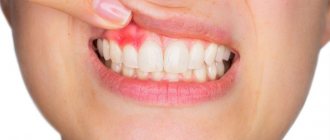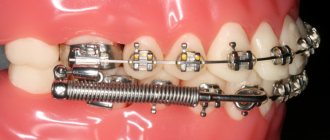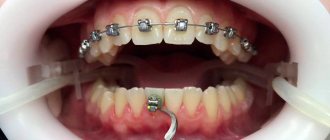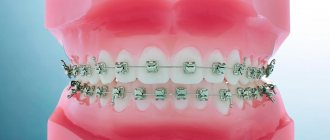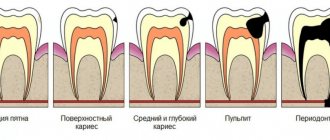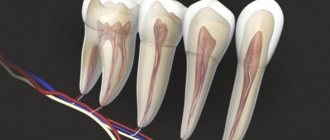Braces are prescribed to straighten the teeth and correct the bite. They have to be worn for quite a long time: from several months to 3 years. During this time, the person may become ill or need to undergo preventive testing. Many people believe that MRIs cannot be done with braces. Let's find out if this is so.
In this article
- What are braces and what are they?
- MRI and braces: which metals do not affect diagnosis
- Myths about MRI and braces
- Alternative to MRI with braces
Magnetic resonance imaging (MRI) is one of the safest and most effective diagnostic methods, which allows many diseases to be identified at an early stage. Its essence is to scan a particular part of the body by exposing it to a magnetic field. The cells of the body react to it in a certain way, which is read by the device and transmitted to the computer. Based on the images obtained, the doctor can not only identify the pathology, but also determine its location, degree and other data that is needed to make an accurate diagnosis and prescribe treatment. An MRI is prescribed during a routine examination or if the following diseases are suspected:
- malignant neoplasms;
- inflammatory processes;
- CNS disorders;
- pathologies of the spine, joints and internal organs.
In other words, using MRI you can scan the entire human body and detect almost any disorder. This is the main advantage of this method. However, its advantage is not only that it is informative, but also that it is safe. There is no ionizing radiation during the examination. MRI does not cause complications, even if performed with the introduction of a contrast agent.
Despite the effectiveness and safety of the technique, there are a number of contraindications to it, for example, the presence of a pacemaker, joint prostheses and other foreign objects in the patient’s body. This especially applies to metal products, which cause distortion of diagnostic data. Let's find out whether orthodontic braces are included in the list of such items, and whether it is possible to do an MRI with braces.
Are MRI scans allowed?
There are a series of myths on this topic. Braces containing metal are said to become magnetized to the appliance and become hot or electric. But none of this is true. During the MRI process, absolutely nothing happens to the metal structure. Its shape, density and properties remain unchanged. The only trouble that can happen is a slight loosening of the system fastenings under the influence of a magnetic field. But this only happens with cheap structures, which are rarely installed today.
Another thing is that the magnetic background created by metal braces distorts the pictures. When the tomograph is turned on, the metal begins to resonate with the field of the device. This causes interference. All sorts of optical effects appear in the photographs. They obscure the doctor’s picture of the patient’s true condition. As a result, there is no chance of a correct diagnosis. And money on MRI screening is wasted.
If the braces are not made of metal, then they will not affect the screening results in any way. When preparing for the examination, ask your orthodontist about the composition of the structure. Most likely, it will be ceramics, heavy-duty plastic or paramagnetic materials (for example, titanium). Any of these options gives the green light to perform an MRI.
MRI and braces: which metals do not affect diagnosis
Before your MRI procedure, tell your doctor what material your braces are made of. This information can be obtained from the orthodontist who installed the structure. The physicochemical properties of various metals differ significantly. Moreover, the reaction to the magnetic field of a particular metal product may be different.
Some of them, for example, titanium structures, do not react at all to the MRI machine and the magnetic waves it creates. Also, braces containing ferromagnets - substances that have spontaneous magnetization - will not interfere with the examination.
In any case, the procedure can be interrupted if the patient feels any discomfort. Before the examination, the doctor gives him a special device with which he can signal that he is not feeling well.
Can someone with braces have a CT scan of their teeth, head or neck?
Here, again, it all depends on the material of your structure. There will be no problems with a polymer alloy, sapphire or ceramic, but metal is again undesirable. X-rays themselves have no effect on it. It’s just that any metal objects degrade the quality of the pictures. For example, a dental CT scan will most likely be done in vain. Neither the upper nor the lower jaw can be seen. The images will show blurry spots and streaks that may interfere with diagnosis. As a result, time and money will be wasted (and the price of a dental CT scan in some clinics is quite high). However, the diagnostician will be able to discern the maxillary sinuses or neck vessels. Therefore, in some cases, computed tomography is still performed.
Well, if there is no metal in the braces, there are no obstacles at all. Feel free to sign up for a CT screening. And for those who have problems with their teeth while wearing braces, even a panoramic photo of the jaw is possible. Of course, the brackets will slightly obscure the view of the dental tissue, but otherwise the picture will be objective.
Myths about MRI and braces
Some people believe that MRI scans performed while there are metal objects in the body can cause electric shocks. Others believe that metal structures, such as braces, become red hot and leave severe burns on (or inside) the body. There is also an opinion that orthodontic brackets lose their functionality or begin to deteriorate under the influence of the magnetic field created by the MRI machine.
All these ideas about tomography are erroneous. The examination does not cause any complications, even if it is carried out while the patient has braces. It’s just that the exposed images obtained during such a study can be treated with skepticism. The doctor will not be able to make an accurate diagnosis and prescribe treatment. However, MRI cannot cause any harm to health. Moreover, it is not capable of damaging the orthodontic structure.
Will I have to remove my braces for the examination?
Most likely you won't have to. Doctors will try to do everything so as not to damage the orthodontist’s work and not disrupt the progress of dental treatment. Removing the structure is allowed only in emergency situations when it comes to saving life and health. In other cases, they will simply select the appropriate diagnosis for you. The doctor will weigh all examination options and choose the best one.
As you can see, the owner of braces on his teeth, in fact, has nothing to fear. The best option is to learn everything about the properties of their material before installing braces.
If for health reasons you often go to the hospital or undergo examinations, it makes sense to immediately order a brace system that will not cause problems during future procedures. For example, ceramic braces are completely inert to the magnetic field and X-radiation, and at the same time cope excellently with the tasks of correcting the bite. And here’s another fact to note for everyone who is going to correct their bite: metals can be ferromagnetic and paramagnetic. The first - steel, nickel or mixtures thereof - can distort diagnostic images. The latter - for example, titanium - do not affect the images in any way. Therefore, if it is absolutely impossible to do without metal in braces or retainers, then let it be titanium.
What are braces and what are they?
Braces are orthodontic structures that help correct bite pathologies. Treatment of dental diseases with their help is a rather lengthy process. Depending on the condition of the teeth, the patient’s age and other factors, it may take several years. During this time, the patient is not insured against other diseases that may require hardware diagnostics, including MRI.
Braces are made from various materials: metal, sapphire, ceramic or plastic. The arch of the structure, which passes through the clasps and exerts the main pressure on the dentition, is usually made of metal. As already noted, it can distort the results of the examination. For this reason, the doctor may prohibit an MRI if the patient wears braces. There is no direct contraindication to the study, but the information obtained during it cannot be trusted 100%.
However, refusal to conduct an MRI is justified only in cases where the head area is being examined. Other parts of the body can be scanned whether or not you have braces.
There are also types of metal that do not affect diagnostic results. Therefore, tomography of the brain or dentofacial apparatus can be carried out even if there are orthodontic structures in the patient’s oral cavity.
Do metal dental implants move during examination?
To understand whether an implant can move under the influence of a magnet, you need to know what it consists of. Dental implants are a modern replacement for your own lost teeth. It consists of a metal implant (reliably fixed in the jaw bone and replaces the tooth root), an abutment (connecting part) and a crown - an analogue of the upper part of the tooth. If the prosthesis is installed efficiently, then it is not at all perceived as a foreign body. It looks like it's your own tooth. These sensations are achieved thanks to the special structure of the implant - it contains micropores, and bone grows into them over time. Thus, it fully replaces the tooth root and does not wobble.
Why the implant does not move during MRI:
- rigid fixation in the jaw: the bone securely holds the tooth root prosthesis in place,
- consists of titanium: i.e. does not magnetize and does not heat up.
Should you tell your doctor that you have dental implants?
A patient with installed dental implants must notify the doctor about this. Then the specialist makes the necessary adjustments, taking into account the location and composition of the prostheses. These settings eliminate the appearance of blurred distortions (also called field artifacts). And then the results of the examination will be clear and precise.
But if a person decides to keep silent about “non-native” teeth, then the picture will turn out blurry, because implants, although slightly, do affect the quality of the pictures. And such a careless patient will have to pay for the procedure and undergo diagnostics again. Why does the blame in this case fall on the patient? Because before the MRI, he will definitely be asked about the presence of implants and what kind of metal they are made of.
“Mom 2 years ago had an MRI of the head and blood vessels, using a high-field tomograph. And she’s had implants installed in her upper jaw for about 5 years now. And nothing, everything went fine. There are no special sensations during the procedure. Just be sure to tell the girls at the reception that there are implants before starting the procedure. They warn the doctor themselves, and then the device is reconfigured.”
Vitalina, from correspondence on the woman.ru forum.
Alternative to MRI with braces
So, are MRIs done with braces? This method for orthodontic braces is prescribed in the following cases:
- Tomography is performed below the head area;
- braces are made of titanium or contain ferromagnets;
- The orthodontic system does not contain metal parts.
If the patient needs to examine the brain or the dental system, and he has metal braces in his mouth that are not made of titanium and without ferromagnets, the doctor prescribes alternative examination methods, for example, CT - computed tomography.
Unlike MRI, which operates on the basis of magnetic waves, CT provides scanning by exposing the body to x-rays. Computed tomography is prescribed for bruises and fractures, dental injuries, bone diseases, internal bleeding and other pathologies. The effectiveness of MRI and CT may vary depending on which organ is being examined and what disease is suspected.
When a patient requires a detailed examination of the jaw, he is usually prescribed a CT scan, since the images obtained using MRI will be overexposed in the places where the braces are. Computed tomography, no less effective than magnetic resonance imaging, allows us to examine the hard tissues of the oral cavity. However, if it is necessary to assess the condition of the soft tissues in the area of the dental system, the doctor may suggest temporarily removing the orthodontic structure. In this case, additional consultation with an orthodontist will be required.
How is a CT scan performed?
No special preparation is required to perform a CT scan. The only requirement for the patient is to remove all metal items: jewelry, piercings, hearing aids.
How is a dental CT scan done? For the patient, everything goes easily, in a standing or sitting position. The chin is placed on a special support-fixator, the head is securely fixed in a stationary state. As with any x-ray, a protective apron is placed on the chest.
During the procedure, the radiation source and detector simultaneously rotate around the patient's head for 20-40 seconds. During this period, you should not move or swallow saliva.
An alternative method of examination with braces is CT
Computed tomography is an alternative to magnetic scanning. The main difference between them is that MRI uses magnetic influence, while CT uses X-rays.
You can do a CT scan with braces. Orthodontic treatment is not a significant contraindication for examination. The only nuance that experts take into account is the material used to make the correction system. During an x-ray, it can be recorded by the system. Therefore, when interpreting the results, it is necessary to pay attention to the error. Automatic interpretation of results may be distorted and show a pathological process where it actually does not exist.
Myths for patients with implants
The most common myth about magnetic resonance imaging scares most patients. An incompetent interlocutor - a work colleague or a neighbor next door - may say in horror: “What, you can’t do a tomography with implants - the prosthesis will be pulled out of the jaw by a magnet and it will stick somewhere, or the device will be damaged.” And the person will believe and refuse MRI in favor of a less informative, but more harmful examination (for example, computed tomography).
Every patient referred for magnetic resonance imaging should remember that dental implants are not a contraindication. And if you are denied such an examination, then you need to look for a clinic with modern equipment and a qualified radiologist.
Author: Vasiliev A. A. (Thank you for your help in writing the article and the information provided)
When you can and cannot do an MRI of the brain with dental implants and metal crowns
Article navigation
- How does MRI work?
- When and who should not undergo the study
- MRI in the presence of an implant
- Do metal dental implants move?
- MRI of the head, brain and neck with implants
- Risks of MRI diagnostics with titanium dentures
- Should I tell my doctor about implants?
- Admission to tomography in the presence of crowns
- MRI of the brain in the presence of braces
- Myths for patients with implants
question to a specialist
In the age of modern technology, only the lazy have not heard of such a wonderful diagnostic device called a tomograph. There are several types, but the most accurate is the magnetic resonance machine. Doctors of various specialties refer for MRI. But a number of patients have a question: is it possible to do an MRI with implants and metal crowns on teeth? The answer to this question will surprise many - read further in our article about diagnostic methods for people with metal dentures and contraindications.
Risks of MRI diagnostics with titanium dentures
Due to the fact that prostheses implanted into the jaw bone are mostly made of paramagnetic titanium, magnetic resonance imaging with dental implants is a completely feasible and completely safe procedure. Titanium is a biologically inert material, i.e. it is not able to oxidize and release harmful substances during contact with bones, muscles and blood vessels of the human body. Of course, in medicine it is not pure titanium that is used, but its alloys with a small amount of other elements. This is done to make the material durable and light. But they also do not have any negative impact when undergoing an MRI.
By the way, titanium is comparable in strength to steel, and in lightness - to aluminum. Therefore, this metal has received recognition not only from dentists, but also from traumatologists and orthopedic surgeons.
Titanium is also used to produce abutments, gum formers, and metal arches (bases) for dentures.
Reviews
In the capital, almost every medical institution has a tomograph and everyone is examined indiscriminately. When I was scheduled for pelvic diagnostics, I had braces. I thought that the procedure would be postponed until the end of treatment or the plates would be removed ahead of schedule. But the doctor convinced that the braces would not interact with the magnetic field, since it affects a completely different area.
Inna, Moscow
They ordered a head examination, and I had braces. There was no time to wait, since a dangerous diagnosis was in question. I found out from the dentist that my braces are made of plastic and there are no metal parts in them. Therefore, I did the procedure without fear and did not regret it. The primary diagnosis was not confirmed.
Egor, Krasnodar
User Questions
Question from Victoria: Tell me, if I have a gold crown in my mouth, is it possible to undergo an MRI of the head with it or is it better to remove the crown?
Answer: Hello, Victoria. Gold is very weakly magnetized, so a gold crown cannot become an obstacle to magnetic resonance imaging of the head. But it will be better if you tell the diagnostic center in advance that you have a metal gold crown. Because it may be necessary to adjust the device for a more accurate study and eliminate distortions.
[1] Sergeeva L. Fixed prosthetics, 2021.


